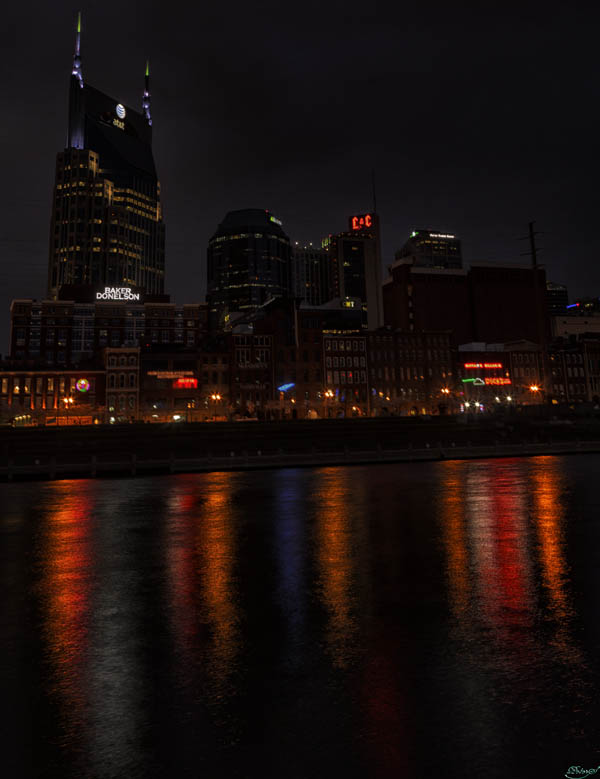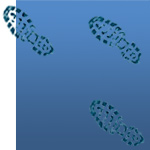|
Digging around in my photo bag to
take that happy shot of yet another waterfall in the Great Smoky Mountains of
Tennessee, I realized the bag's contents had evolved over the miles to just
what an outdoor photographer needed to capture wild places, but with weight
kept to a minimum. The links below are for info only -- always see what is
current and best priced (not always Amazon).
Nice camera backpacks usually start
well over $100, but being a cheapskate, mine came from
Walmart for $50.

Other than a stitch here and there, the only
major enhancement has been some gorilla tape along the bottom where just about
any knapsack would wear away after enough miles.

Yes, this makes the pack look a bit
ratty, but you want that. Remember that this bag will be jammed with expensive
toys made as light as possible. To keep it from running down the street, don't
emblazon Canon or Nikon all over it. Make it look like the home of a couple of
Limburger sandwiches.
The main feature of my
tripod is that its legs are carbon fiber with flip locks,
not the friction rings of my previous tripod (always slipping). The main
feature of its
ball head is the ability to quickly swing the camera to the
side to take vertical (portrait) shots. I never had much use for the 3 separate
adjustment knobs common to most ball heads.
Inside the bag is my Canon
Rebel T1i (check for later version), not because Canon is
the best, or because it's their best model. The religious wars between Canon
and Nikon fans forget that it's not the horse but the jockey. Canon makes lots
nicer cameras, but they tend to be heavier and your first dozen trail miles
will have you questioning whether you need all those bells and whistles. Save
your dough for lenses.

The 24-100mm general-purpose
zoom lens on the camera covers most situations. The 100mm
1:2.8
macro lens is for close-up work, and the 8-15mm
fisheye lens is for when the cliff won't let you step back
to take it all in. All are Canon just so I don't have to deal with integration
issues, and each has a lens cap and a padded lens bag.
Rarely used because I try to avoid
flash shots, the Speedlite
flash is needed sometimes. I waterproof sprayed the nylon
ditty bag so I can
pull it over camera and lens in an unexpected rain. You can use a plastic
grocery bag, but never let even a mist hit your camera.
The Illuminator outfit makes a
small, collapsible, cheap
reflector for lighting the underside of things, and a
diffuser to soften harsh sunlight.

Below that is my drugstore head
lamp for night rambles, though you'll get your best shots learning to get
around by the light of the moon. Below that is my skeeter repellent, emergency
rations, and the camera's manual.
Most people laugh at the idea of
dragging around a dog-eared manual, preferring instead to learn their camera
through some form of psychic osmosis. They claim to "learn by doing", which I
assume is to push camera buttons until something useful happens. Since modern
cameras are a veritable porcupine of knobs and dials, I prefer to use hiking
breaks to find some obscure feature in the manual, try it out, and then get
back on the trail. After all these years, I can still find more of those hidden
gems. Pay extra to get paper if you have to, and then read it thoroughly and
often to get your money's worth.
Next group of toys begins with
spare batteries. Why at least three? Consider the likely scenario for finding
out you have a bad battery. Your main battery has just drained normally when
you reach for the bad battery. If you don't have a third battery at that point,
you will no longer be fun to be with.

In the bottom-left of the shot
above are my filters in a CD carry case. The polaroid is to cut water glare and
such as that. Others include the 0.6 and 0.9 neutral density
filters to cut down light when I can't stop down the
aperture any further. Let's say I want to keep the lens open for 0.4 seconds to
get that silky look to a waterfall. No matter how you stop down (f32 or
smaller), you'll still get too much light. That's where neutral density filters
come in. You can spend lots of money buying filter brackets and spend lots of
time attaching them to lenses, or you can just hold them in front of the lens.
Guess which I prefer.
The snake thing is called a
plamp. One end clamps to a tripod leg, and the other to the
stem of a flower moving around in the wind -- and your macro shot is
rescued.
Top-right are cables and a
white-balance metering standard, clearly just an option if you're shooting the
RAW file standard.
Below that is a little plastic bag
with remote shutter trigger, Allen wrenches for tripod, head, and brackets, a
small spare memory card for the camera, lens cleaning stuff, and a tiny spray
bottle of glycerin. Glycerin is a clear, harmless liquid that beads up much
larger than water. Cool flower droplets and spider web beads.
For under $40, I'd say my
programmable
cable release is a bargain. You should try to take all
tripod pictures with mirror lockup and a cable release to minimize camera
vibration. But this cable release's programming also supports lens speeds way
past the 30-second max of many cameras (important for night shots), and you can
set it to make time-lapse videos.

The photography
gloves only go out on winter trips, but on those, they make
the difference between being able to wait out the perfect shot, or fumbling
with regular mittens.
Besides the bag, I carry
bear spray when deep in the forest. Designed for grizzlies
(which I encountered only once in my life), this is also handy for other
annoying critters, four or two legged. Given that I like creeping around
forests at night, it makes me feel good to have the power of a skunk. Disregard
all the complex wind direction instructions. If the shit hits the fan, you'll
just aim and shoot. Practice a quick draw, arming, aiming, holding your breath,
and narrowing your eyes.

The
viewfinder hood makes a big difference on sunny
days.
Besides being my Plan B camera, the
above Lumix underwater
camera is also my shoot-from-the-hip critter cam. Whereas I
take forever to twitter all the dials for a landscape shot on my regular
camera, the bears, deer, raccoons, etc. are not posers. The Lumix has most
settings on auto so I can instantly shoot unexpected visitors and ask questions
later. You can do the same with a cheaper GoPro, but those have virtually zero
settings. That's like handing Mozart a banjo with one string.
Not pictured is the
lens
hood against glare, and my
monopod with feet for the many places tripods are not
allowed (museums, caves, etc).
Lots more in my toy chest for
special occasions, but this bedtime story has grown long enough for
now. |

Shiloh, where mass casualties began

So young

The ground was strewn with the dead of the enemy and our own,
mangled in every conceivable way.
-- Capt. Samuel Latta, 13th Tennessee
Infantry, C.S.A.

A
trickle without a name on a trail without a name

Fall Hollow near the Natchez Trace

Jackson Falls

Nashville

Music City reflections

White dogwood, redbud trees, and
the countryside was clothed
in flowers

Pantheon knock off
 |
| For more pictures of Tennessee, click here. |
 |
|


















